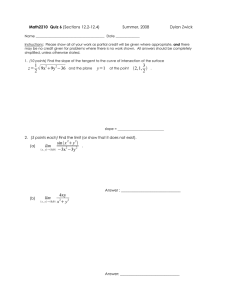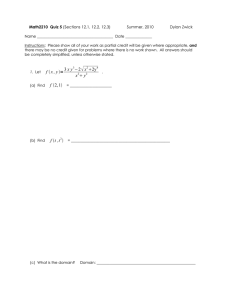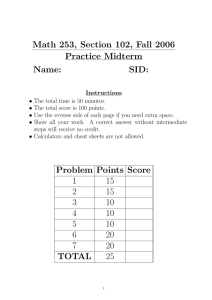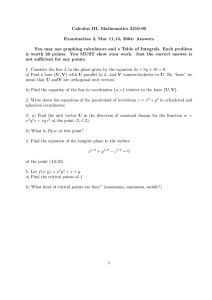Practice Problems: Midterm Exam
advertisement
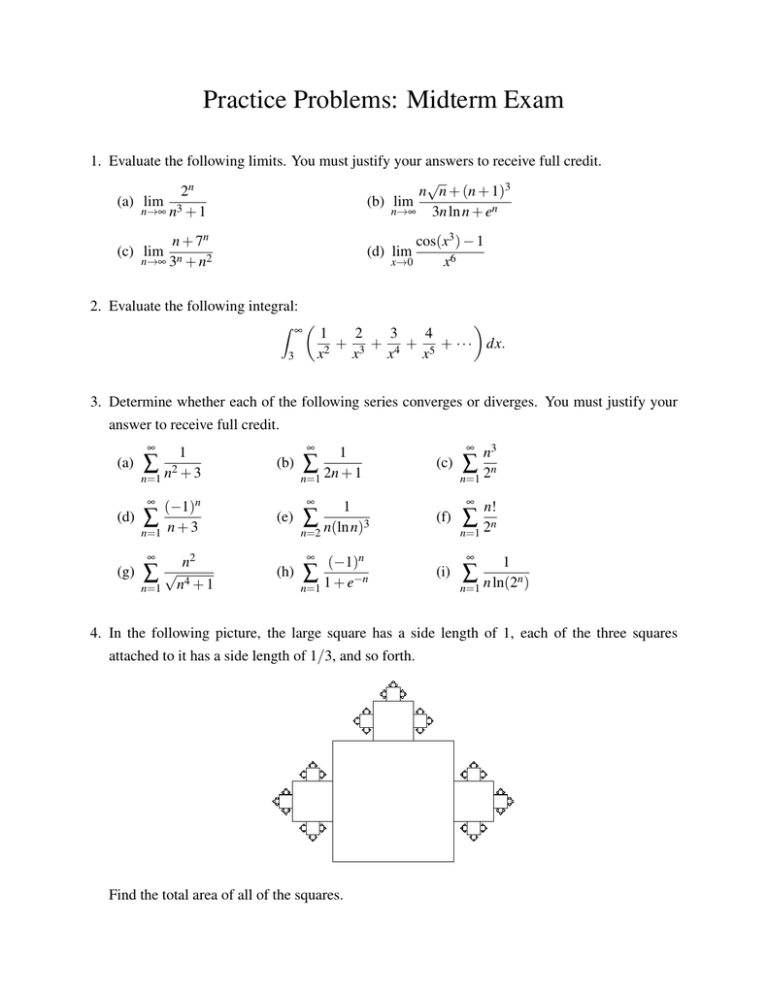
Practice Problems: Midterm Exam 1. Evaluate the following limits. You must justify your answers to receive full credit. √ 2n n n + (n + 1)3 (a) lim 3 (b) lim n→∞ n + 1 n→∞ 3n ln n + en cos(x3 ) − 1 (d) lim x→0 x6 n + 7n (c) lim n n→∞ 3 + n2 2. Evaluate the following integral: Z ∞ 1 2 3 4 + 3 + 4 + 5 + · · · dx. x2 x x x 3 3. Determine whether each of the following series converges or diverges. You must justify your answer to receive full credit. ∞ 1 (a) ∑ 2 n=1 n + 3 ∞ 1 (b) ∑ n=1 2n + 1 (−1)n ∑ n=1 n + 3 (e) n2 √ ∑ 4 n=1 n + 1 (h) n3 ∑ 2n n=1 ∞ 1 ∑ n(ln n)3 n=2 (f) (−1)n ∑ −n n=1 1 + e (i) n! ∑ 2n n=1 ∞ ∞ (g) (c) ∞ ∞ (d) ∞ ∞ 1 ∑ n ln(2n) n=1 4. In the following picture, the large square has a side length of 1, each of the three squares attached to it has a side length of 1/3, and so forth. Find the total area of all of the squares. ∞ 5. (a) Find the sum of the series ∑ x3+4n, assuming −1 < x < 1. n=0 3n n ∑ 2x . n=1 n ∞ (b) Find the radius of convergence of the power series (c) Find the Taylor series for the function f (x) = x3 sin(x2 ). Express your answer in summation notation. (d) Find the first three terms of the Taylor series for the function f (x) = 6. p x + 25. (a) Find the distance between the planes x + 8y + 4z = 12 and x + 8y + 4z = 30. (b) Find the equation of the plane containing the lines r(t) = (2, 1 + t, 3 + 2t) r(t) = (2 − t, 1 + 4t, 3 + t). and (c) Find the point on the plane 2x + 3y + 6z = 6 that is closest to the point (2, 1, 1). 7. Let L be the line r(t) = (2 + 3t, 3 − 2t, 1 + t), and let P be the plane x + 2y + z = 4. Find the equation of the plane perpendicular to P that contains the line L. 8. In the following picture, a rectangle is tangent to the ellipse x2 + 4y2 = 13 at the point (3, 1). Find the coordinates of the point P. 4 2 H3, 1L 9. P 2 2 (a) Find the equation of the tangent plane to the surface z = x2 + y2 at the point (1, 1, 2). (b) A unit sphere is tangent to the outside of the surface z = x2 + y2 at the point (1, 1, 2). Find the coordinates of the center of the sphere. 10. ∂f if f (x, y) = x sin(xy). ∂x (b) Find ∇f (3, 5) if f (x, y) = x 2 y. (a) Find (c) Find a function f (x, y) so that ∂ 3f = x 2. ∂x ∂y 2 (d) Let f : R2 → R3 be the function f(x, y) = y3 , x2 , xy . Compute Df(x, y). (e) Find the directional derivative of the function f (x, y) = 5x2 sin(2y) in the direction of the unit vector (3/5, 4/5). (x + y)2 (x,y)→(0,0) x2 + y2 (f) Use polar coordinates to evaluate lim 11. The following figures show the graphs of f (x, y) as a function of x for several different values of y. y = 0.4 y = 0.5 y = 0.6 30 30 30 25 25 25 f Hx,yL 15 f Hx,yL 15 f Hx,yL 15 10 10 10 5 5 5 0 0 0 0 20 20 0.25 0.5 0.75 1 20 0.25 x 0.5 0.75 0 0 1 0.25 x Use this information to estimate the values of 0.5 0.75 1 x ∂f ∂f (0.5, 0.5) and (0.5, 0.5). ∂x ∂y 12. Let f : R2 → R2 , and suppose that f(3, 5) = (−1, 2) and Df(3, 5) = " # 1 0 5 2 . (a) Use a linear approximation to estimate the value of f(3.01, 5.04). (b) Estimate the values of x and y for which f(x, y) = (−1.02, 2.06). " # 1 2 (c) Let g : R2 → R2 be another function, and suppose that Dg(−1, 2) = . Use the chain 3 4 rule to compute D(g ◦ f)(3, 5) 13. (a) Find the tangent plane to the surface xz3 − yz = 4 at the point (1, 2, 2). (b) Find parametric equations for the normal line to the surface at this point.
